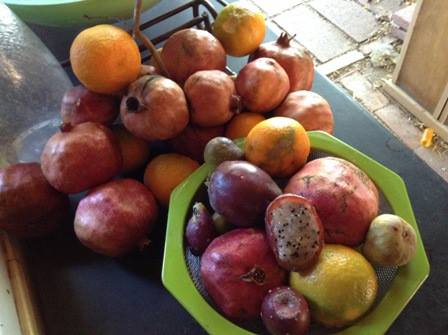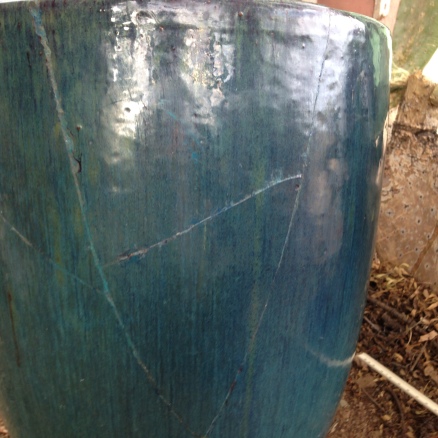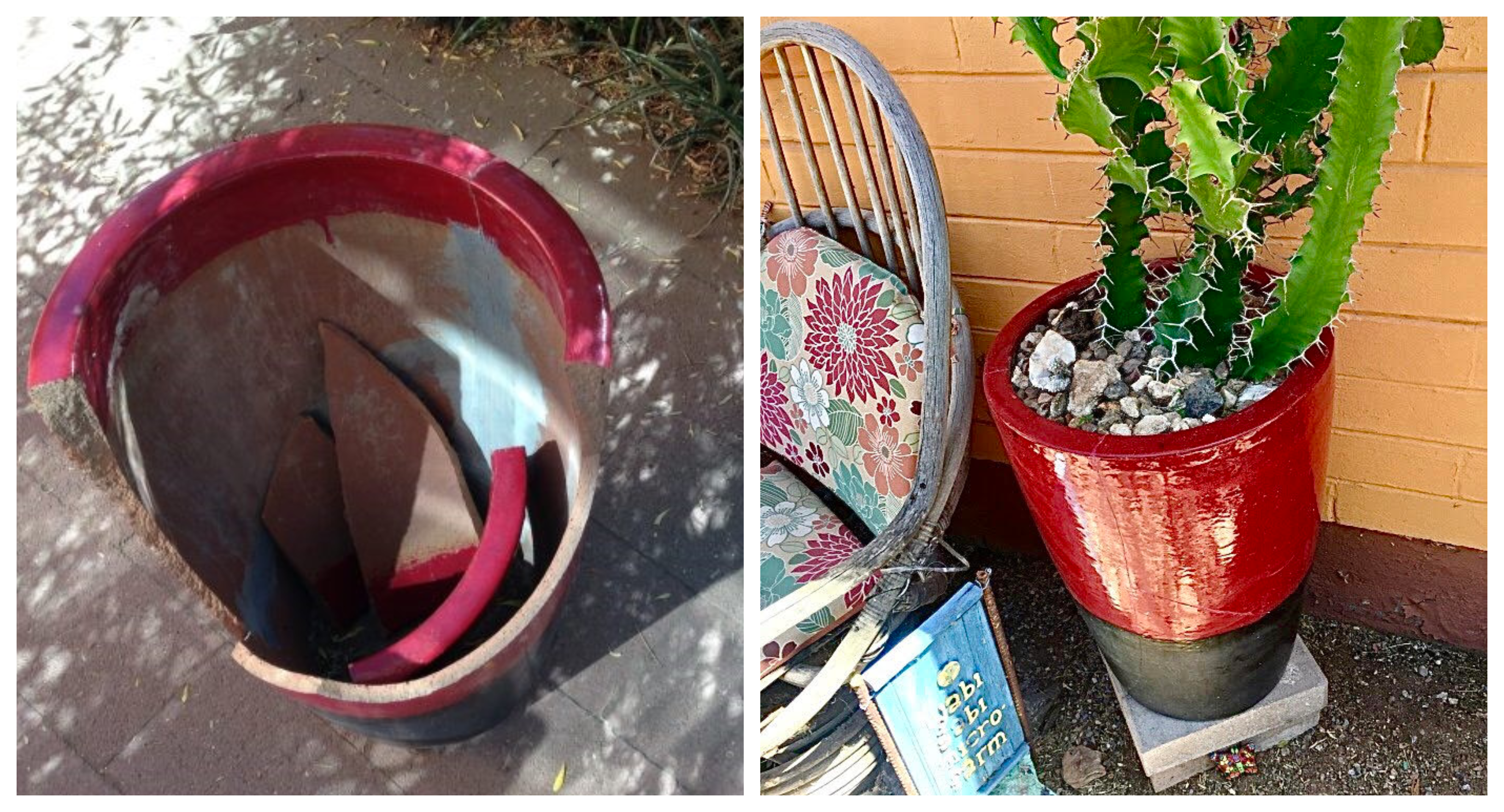Guest post by Terry Owen
Welcome to the first guest contribution to New Stuff Sucks!
Terry Owen is a fitting choice, as he and I have been exchanging subcultural DNA for more than eight years. Mine now responds to old movies, classic comics, and heretofore unfamiliar music, while his now inspires him to check out Dumpsters, pick pods from trees, and bake cookies under glass in the sun. Read all about it . . .
______________________________________________
When I was made aware, relatively late in life, of the astonishing varieties of wild, harvestable food in Tucson that I had somehow previously failed to register, scales began falling from my eyes.
It would be wrong to classify this awareness as an epiphany, or some kind of Damascus Road incident. Moreover, the sheer number of these occluders meant that some time was required before the last holdout was finally jettisoned. (A few of them were admittedly difficult to relinquish; I had grown rather accustomed to their opacity over the past several decades.)
My first experience with the world I was now perceiving—inspired by a new relationship that was afoot—was not, however, particularly auspicious.
During the early stages of our courtship, Kay—my soon-to-be partner—had asked if I would go with her to gather saguaro fruit on a patch of undeveloped desert at the base of a small mountain out on West Speedway. (In truth, she needed a car to get to the location.) Anxious to accrue possible relationship points, I readily agreed.
Kay had, some time before, fashioned several poles from a variety of found metal materials that approximated those made from saguaro ribs used by Tohono O’Odham harvesters . On a hot and windy June day, we loaded the poles into the car and headed west. When I stumbled up the hill and made my first awkward attempts to pummel the fruit from the cactus arms several feet above, three things quickly became apparent: 1), that I was wearing the wrong shoes for the treacherous, rocky landscape we were negotiating; 2), that I was seriously out of shape; and 3), that maneuvering and keeping upright a thin pole in the face of explosive wind gusts (while simultaneously maintaining my balance on the uneven surface and slippery rock ) was occupying nearly the whole of my attention, to the detriment of my stated mission.
Indeed, none of the fruit I was ineffectually belaboring seemed even mildly concerned that I would ever succeed in dislodging them from the heights they occupied. Several birds agreed with this assessment and gave voice to their disdain.
Drenched with sweat and nearly fruitless, I declared myself done after about an hour and found a patch of shade in which to rest. I assumed that Kay would soon tire of the exertion and we could get back to the comfort of a building. While resting, I sometimes caught fleeting glimpses of her in the distance, bounding about the rocks like a bipedal mountain goat, her bag burgeoning with fruit that she would later process into syrup and candy.
I realized, however, when the sun was setting and her hunt was finally over, that she was in a state of quiet bliss. Indeed, I had never before seen her so happy. She was especially delighted by the sun-caramelized bits she had gathered. These were leathery pieces that had been ejected from the fruit’s rind after it had fallen to the ground. “Better than candy!” she said, eating a handful.
Despite this unpromising start, and as Kay and I spent more time together, my ideas about what was truly important about the area in which I lived began to change and evolve. Previously, I had been focused primarily on city matters—this building, that road, those neighborhoods—with the desert being nothing more than a somewhat exotic backdrop. Now, I began to see the human-built town as transitory, ephemeral, ultimately of little consequence; the important stuff was found outside all the air-conditioned rooms. (Note to self: does that sound holier-than-thou? Possibly remove that last bit.)
Kay’s organic instruction proceed in a natural, non-didactic fashion. During our evening walks, for example, she would point out various seeds and fruits and berries that were edible. Some of these were popped into my mouth before I could raise an objection. “You just ate a hackberry!” she said. “Isn’t it delicious?”
On one occasion, I watched in wonder as she ate the ends of some mesquite pods, comparing the relative sweetness of pods from different trees. I had never known anyone to behave in this manner. I was fascinated. (And hooked.)
As we wandered down alleys, she indicated patches of wild mustard, or arugula, or purslane, or amaranth, or cheese weed, all perfect for use as salad greens. Although I dutifully tried to remember the appearance and use of each plant, to this day I still can’t quite sort them all out. During summer months, we began looking for pomegranates, busy ripening into reddish balls, or palm tree dates that opted for a more stylish purple hue; these we collected, took home, prepared, and consumed. We took note of the many alleys that were bristling with fig or citrus trees, the fruit of which we harvested while adhering to the unspoken rule that any tree branch extending past a yard barrier was fair game for the public. (We learned this rule does not apply in the Sam Hughes neighborhood, many denizens of which apparently remain by their windows throughout the day, that they may cry alarm at any perceived fruit transgressions.)
The orgy of food continued. We plucked prickly pear fruit with tongs, and made juice from it; gathered yucca tree flowers and made creamed soup out of the petals. We consumed wolfberries like candy. We ate paloverde sprouts and, from mature trees, extracted seeds that resembled (and tasted like) edamame. One year, blueberry tomato plants suddenly became a “thing.” An errant seed from an heirloom tomato package having (presumably) made its way to the soil, our yard was soon overrun with these multiplying plants, which, despite being as relentless as buffelgrass (and as almost as difficult to eradicate), yet produced deliciously tiny fruit, which we enjoy as snacks or as a salad supplement. (Our three chickens are obsessed with these black globes.)
During one brief alley walk, we found thirteen different types of edibles.

During my apprenticeship, I became quite enamored of mesquites, a local tree I had somehow failed to pay much heed to in previous decades. Indeed, this appreciation has grown to the point that I now consider myself a fully-fledged mesquitarian. I admire this tree because of its beauty, its strength, its durability, its drought tolerance, the lives it supports, and the glorious shade it produces. Most of all, I appreciate the tree for its pods.

I used to see thousands of smashed mesquite pods in the streets and on the sidewalks during the summer and think: “What an unsightly mess.” With my altered perspective, I now looked at the pods and thought: “What a tremendous loss of food.” This is the dark side of urban harvesting that no one prepares you for: the shocking realization of how much food is actually wasted. Kay once wrote an article for Edible Baja Arizona, “Walking on Food,” about this very phenomenon.
In the early days of our relationship, Kay and I would gather mesquite pods from our yard and take them to a neighborhood hammer mill, from which flour would be produced. Not being comfortable with crowds or interminable waiting—not to mention the anxiety of having one’s pods forensically inspected by unforgiving judges—I eventually chose to forego the middleman and grind the pods myself with a cheap thrift-store blender. It is an enjoyably deliberative and recursive process: grinding the pods, dumping them into a strainer, putting the remaining chaff back into the blender, regrinding them for a few moments . . . the beautiful thing is that nothing is wasted. The chaff left over from the second grinding is then used as the basis for a refreshing atole drink. (Now if I could only find a solar-powered blender . . . )
From my friend Andy, I learned a recipe for making mesquite flour cookies, a recipe that is open for alteration depending on one’s tastes. We don’t use the stove for making these cookies, but rather employ the solar oven that Kay from a broken-down washing machine.
Because of my altered relationship with the landscape, I began to divest myself of previous habits, such as mindlessly driving everywhere. (Nowadays, driving a car seems like an act of madness.) I began to walk and ride my bike, which resulted in far less strain on the heart and mind, as well as the obvious environmental benefits. Instead of dreading the desert summer, as I used to every May, I began to appreciate the wonderful provender and opportunities the season provided. Going beyond food, I stopped purchasing many materials from stores whenever a perceived need arose; I found that alleys, certain favored Dumpsters, and the biannual Brush and Bulky Week (my favorite holiday!), would usually deliver that which I was lacking. In fact, it seemed almost magical the way materials would frequently appear. As an example: we needed large pots to replant some of our burgeoning cacti and succulents, which had outgrown their containers; almost immediately, it seems, we came across two large and broken pots in a nearby alley. We dragged them out, Kay reglued the pots and repainted the seams, and they now look even more beautiful than when they first were made. (Or so I believe.)


I will also say that I now thoroughly enjoy our annual saguaro fruit-plucking expeditions. I have become more adept over time, and count the ability to dislodge a fruit and catch it before it hits the ground one of the chief pleasures of my life.


OMG this is amazing. what a guy, what a writer!
would you be willing for me to share this post on my btf fb page, do you want more readers of the blog, etc?
hugs, b.
Barbara Rose Bean Tree Farm Tucson AZ beantreefarm.com
“Do unto ecosystems as you would have them do unto you.” Douglas Chadwick
LikeLike
Lovely piece that made me laugh and wish for a cookie!
LikeLike
Many thanks. A joy to read, and rather 19th-centuryish. Gotta recommend to all Southwest Foraging by John Slattery, also a Tusconan. Wide range of wild foods to find here, clear photos, and ways to use the bounty. Best regards.
LikeLike
I here Mr Owen gives great foot massages too.
LikeLike
Bravo!! that reminds me of my first fruit picking escapade! good stuff!
LikeLike